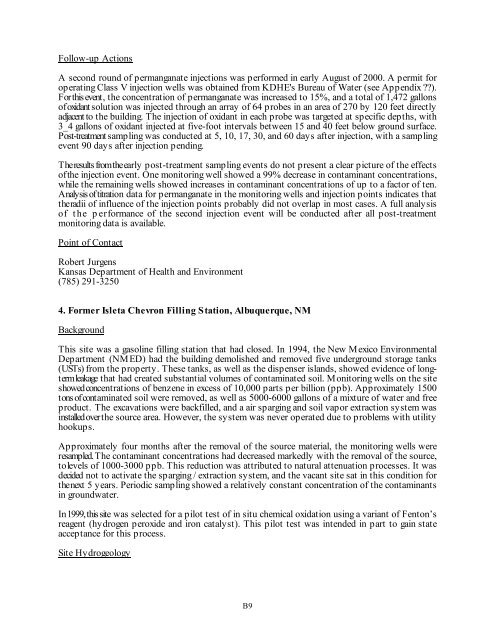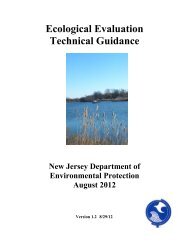Technical and Regulatory Guidance for In Situ Chemical ... - ITRC
Technical and Regulatory Guidance for In Situ Chemical ... - ITRC
Technical and Regulatory Guidance for In Situ Chemical ... - ITRC
Create successful ePaper yourself
Turn your PDF publications into a flip-book with our unique Google optimized e-Paper software.
Follow-up Actions<br />
A second round of permanganate injections was per<strong>for</strong>med in early August of 2000. A permit <strong>for</strong><br />
operating Class V injection wells was obtained from KDHE's Bureau of Water (see Appendix ).<br />
For this event, the concentration of permanganate was increased to 15%, <strong>and</strong> a total of 1,472 gallons<br />
of oxidant solution was injected through an array of 64 probes in an area of 270 by 120 feet directly<br />
adjacent to the building. The injection of oxidant in each probe was targeted at specific depths, with<br />
3_4 gallons of oxidant injected at five-foot intervals between 15 <strong>and</strong> 40 feet below ground surface.<br />
Post-treatment sampling was conducted at 5, 10, 17, 30, <strong>and</strong> 60 days after injection, with a sampling<br />
event 90 days after injection pending.<br />
The results from the early post-treatment sampling events do not present a clear picture of the effects<br />
of the injection event. One monitoring well showed a 99% decrease in contaminant concentrations,<br />
while the remaining wells showed increases in contaminant concentrations of up to a factor of ten.<br />
Analysis of titration data <strong>for</strong> permanganate in the monitoring wells <strong>and</strong> injection points indicates that<br />
the radii of influence of the injection points probably did not overlap in most cases. A full analysis<br />
of t he p er<strong>for</strong>mance of the second injection event will be conducted after all post-treatment<br />
monitoring data is available.<br />
Point of Contact<br />
Robert Jurgens<br />
Kansas Department of Health <strong>and</strong> Environment<br />
(785) 291-3250<br />
4. Former Isleta Chevron Filling Station, Albuquerque, NM<br />
Background<br />
This site was a gasoline filling station that had closed. <strong>In</strong> 1994, the New Mexico Environmental<br />
Department (NMED) had the building demolished <strong>and</strong> removed five underground storage tanks<br />
(USTs) from the property. These tanks, as well as the dispenser isl<strong>and</strong>s, showed evidence of longterm<br />
leakage that had created substantial volumes of contaminated soil. Monitoring wells on the site<br />
showed concentrations of benzene in excess of 10,000 parts per billion (ppb). Approximately 1500<br />
tons of contaminated soil were removed, as well as 5000-6000 gallons of a mixture of water <strong>and</strong> free<br />
product. The excavations were backfilled, <strong>and</strong> a air sparging <strong>and</strong> soil vapor extraction system was<br />
installed over the source area. However, the system was never operated due to problems with utility<br />
hookups.<br />
Approximately four months after the removal of the source material, the monitoring wells were<br />
resampled. The contaminant concentrations had decreased markedly with the removal of the source,<br />
to levels of 1000-3000 ppb. This reduction was attributed to natural attenuation processes. It was<br />
decided not to activate the sparging / extraction system, <strong>and</strong> the vacant site sat in this condition <strong>for</strong><br />
the next 5 years. Periodic sampling showed a relatively constant concentration of the contaminants<br />
in groundwater.<br />
<strong>In</strong> 1999, this site was selected <strong>for</strong> a pilot test of in situ chemical oxidation using a variant of Fenton’s<br />
reagent (hydrogen peroxide <strong>and</strong> iron catalyst). This pilot test was intended in part to gain state<br />
acceptance <strong>for</strong> this process.<br />
Site Hydrogeology<br />
B9
















